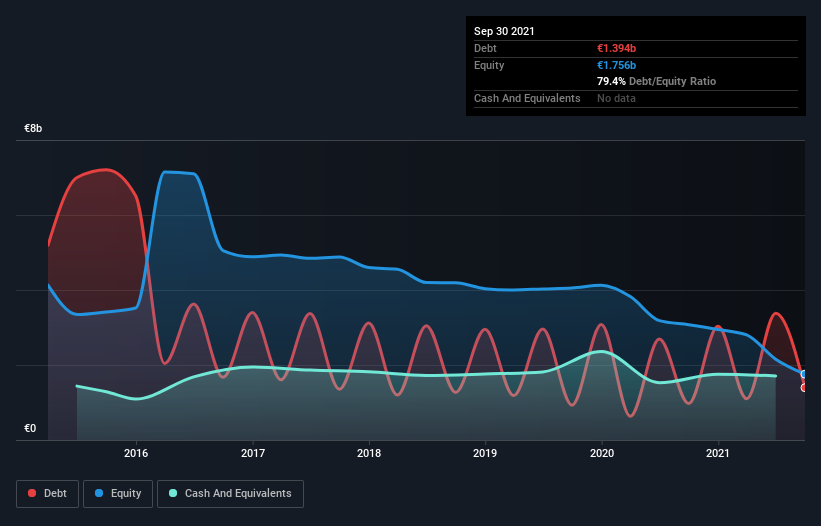
The external fund manager backed by Berkshire Hathaway's Charlie Munger, Li Lu, makes no bones about it when he says 'The biggest investment risk is not the volatility of prices, but whether you will suffer a permanent loss of capital.' It's only natural to consider a company's balance sheet when you examine how risky it is, since debt is often involved when a business collapses. We note that Saipem SpA (BIT:SPM) does have debt on its balance sheet. But should shareholders be worried about its use of debt?
When Is Debt Dangerous?
Debt assists a business until the business has trouble paying it off, either with new capital or with free cash flow. If things get really bad, the lenders can take control of the business. While that is not too common, we often do see indebted companies permanently diluting shareholders because lenders force them to raise capital at a distressed price. Of course, the upside of debt is that it often represents cheap capital, especially when it replaces dilution in a company with the ability to reinvest at high rates of return. When we think about a company's use of debt, we first look at cash and debt together.
See our latest analysis for Saipem
How Much Debt Does Saipem Carry?
As you can see below, at the end of September 2021, Saipem had €1.39b of debt, up from €973.0m a year ago. Click the image for more detail. But on the other hand it also has €1.71b in cash, leading to a €315.0m net cash position.

How Strong Is Saipem's Balance Sheet?
The latest balance sheet data shows that Saipem had liabilities of €519.0m due within a year, and liabilities of €1.89b falling due after that. Offsetting this, it had €1.71b in cash and €3.94b in receivables that were due within 12 months. So it can boast €3.24b more liquid assets than total liabilities.
This surplus strongly suggests that Saipem has a rock-solid balance sheet (and the debt is of no concern whatsoever). With this in mind one could posit that its balance sheet means the company is able to handle some adversity. Simply put, the fact that Saipem has more cash than debt is arguably a good indication that it can manage its debt safely. The balance sheet is clearly the area to focus on when you are analysing debt. But ultimately the future profitability of the business will decide if Saipem can strengthen its balance sheet over time. So if you're focused on the future you can check out this free report showing analyst profit forecasts.
In the last year Saipem had a loss before interest and tax, and actually shrunk its revenue by 9.3%, to €7.0b. That's not what we would hope to see.
So How Risky Is Saipem?
Statistically speaking companies that lose money are riskier than those that make money. And we do note that Saipem had an earnings before interest and tax (EBIT) loss, over the last year. And over the same period it saw negative free cash outflow of €253m and booked a €1.2b accounting loss. With only €315.0m on the balance sheet, it would appear that its going to need to raise capital again soon. Overall, its balance sheet doesn't seem overly risky, at the moment, but we're always cautious until we see the positive free cash flow. When analysing debt levels, the balance sheet is the obvious place to start. However, not all investment risk resides within the balance sheet - far from it. To that end, you should be aware of the 1 warning sign we've spotted with Saipem .
At the end of the day, it's often better to focus on companies that are free from net debt. You can access our special list of such companies (all with a track record of profit growth). It's free.
New: Manage All Your Stock Portfolios in One Place
We've created the ultimate portfolio companion for stock investors, and it's free.
• Connect an unlimited number of Portfolios and see your total in one currency
• Be alerted to new Warning Signs or Risks via email or mobile
• Track the Fair Value of your stocks
Have feedback on this article? Concerned about the content? Get in touch with us directly. Alternatively, email editorial-team (at) simplywallst.com.
This article by Simply Wall St is general in nature. We provide commentary based on historical data and analyst forecasts only using an unbiased methodology and our articles are not intended to be financial advice. It does not constitute a recommendation to buy or sell any stock, and does not take account of your objectives, or your financial situation. We aim to bring you long-term focused analysis driven by fundamental data. Note that our analysis may not factor in the latest price-sensitive company announcements or qualitative material. Simply Wall St has no position in any stocks mentioned.
About BIT:SPM
Good value with proven track record.
Similar Companies
Market Insights
Community Narratives



